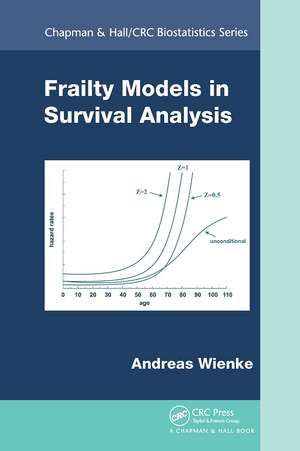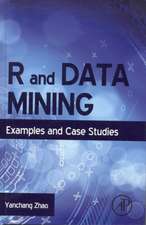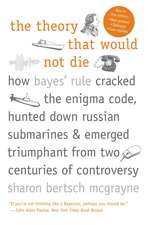Frailty Models in Survival Analysis: Chapman & Hall/CRC Biostatistics Series
Autor Andreas Wienkeen Limba Engleză Paperback – 14 oct 2024
The book extensively explores how univariate frailty models can represent unobserved heterogeneity. It also emphasizes correlated frailty models as extensions of univariate and shared frailty models. The author analyzes similarities and differences between frailty and copula models; discusses problems related to frailty models, such as tests for homogeneity; and describes parametric and semiparametric models using both frequentist and Bayesian approaches. He also shows how to apply the models to real data using the statistical packages of R, SAS, and Stata. The appendix provides the technical mathematical results used throughout.
Written in nontechnical terms accessible to nonspecialists, this book explains the basic ideas in frailty modeling and statistical techniques, with a focus on real-world data application and interpretation of the results. By applying several models to the same data, it allows for the comparison of their advantages and limitations under varying model assumptions. The book also employs simulations to analyze the finite sample size performance of the models.
| Toate formatele și edițiile | Preț | Express |
|---|---|---|
| Paperback (1) | 309.05 lei 6-8 săpt. | |
| CRC Press – 14 oct 2024 | 309.05 lei 6-8 săpt. | |
| Hardback (1) | 1114.70 lei 6-8 săpt. | |
| CRC Press – 26 iul 2010 | 1114.70 lei 6-8 săpt. |
Din seria Chapman & Hall/CRC Biostatistics Series
-
 Preț: 386.62 lei
Preț: 386.62 lei -
 Preț: 355.91 lei
Preț: 355.91 lei - 8%
 Preț: 531.50 lei
Preț: 531.50 lei -
 Preț: 341.42 lei
Preț: 341.42 lei -
 Preț: 350.65 lei
Preț: 350.65 lei -
 Preț: 354.77 lei
Preț: 354.77 lei - 5%
 Preț: 656.94 lei
Preț: 656.94 lei -
 Preț: 342.89 lei
Preț: 342.89 lei -
 Preț: 288.80 lei
Preț: 288.80 lei -
 Preț: 311.41 lei
Preț: 311.41 lei - 9%
 Preț: 644.57 lei
Preț: 644.57 lei - 8%
 Preț: 376.64 lei
Preț: 376.64 lei -
 Preț: 372.30 lei
Preț: 372.30 lei -
 Preț: 356.63 lei
Preț: 356.63 lei - 8%
 Preț: 418.23 lei
Preț: 418.23 lei - 9%
 Preț: 608.32 lei
Preț: 608.32 lei - 9%
 Preț: 766.27 lei
Preț: 766.27 lei -
 Preț: 378.11 lei
Preț: 378.11 lei -
 Preț: 356.63 lei
Preț: 356.63 lei - 9%
 Preț: 684.19 lei
Preț: 684.19 lei - 9%
 Preț: 594.78 lei
Preț: 594.78 lei -
 Preț: 311.41 lei
Preț: 311.41 lei -
 Preț: 354.48 lei
Preț: 354.48 lei - 9%
 Preț: 833.28 lei
Preț: 833.28 lei - 9%
 Preț: 684.46 lei
Preț: 684.46 lei - 9%
 Preț: 682.67 lei
Preț: 682.67 lei -
 Preț: 362.00 lei
Preț: 362.00 lei - 9%
 Preț: 940.38 lei
Preț: 940.38 lei - 18%
 Preț: 791.14 lei
Preț: 791.14 lei - 18%
 Preț: 706.57 lei
Preț: 706.57 lei - 18%
 Preț: 1730.31 lei
Preț: 1730.31 lei - 26%
 Preț: 875.13 lei
Preț: 875.13 lei - 18%
 Preț: 785.60 lei
Preț: 785.60 lei - 25%
 Preț: 825.63 lei
Preț: 825.63 lei - 15%
 Preț: 678.14 lei
Preț: 678.14 lei - 25%
 Preț: 557.58 lei
Preț: 557.58 lei - 25%
 Preț: 625.83 lei
Preț: 625.83 lei - 18%
 Preț: 786.38 lei
Preț: 786.38 lei - 25%
 Preț: 778.07 lei
Preț: 778.07 lei - 25%
 Preț: 628.29 lei
Preț: 628.29 lei - 18%
 Preț: 1124.97 lei
Preț: 1124.97 lei - 25%
 Preț: 887.55 lei
Preț: 887.55 lei - 25%
 Preț: 526.81 lei
Preț: 526.81 lei - 25%
 Preț: 560.34 lei
Preț: 560.34 lei - 15%
 Preț: 479.86 lei
Preț: 479.86 lei - 18%
 Preț: 1017.63 lei
Preț: 1017.63 lei
Preț: 309.05 lei
Preț vechi: 350.65 lei
-12% Nou
Puncte Express: 464
Preț estimativ în valută:
59.14€ • 61.37$ • 49.43£
59.14€ • 61.37$ • 49.43£
Carte tipărită la comandă
Livrare economică 15-29 martie
Preluare comenzi: 021 569.72.76
Specificații
ISBN-13: 9781032922065
ISBN-10: 1032922060
Pagini: 324
Ilustrații: 22
Dimensiuni: 156 x 234 mm
Greutate: 0.6 kg
Ediția:1
Editura: CRC Press
Colecția Chapman and Hall/CRC
Seria Chapman & Hall/CRC Biostatistics Series
Locul publicării:Boca Raton, United States
ISBN-10: 1032922060
Pagini: 324
Ilustrații: 22
Dimensiuni: 156 x 234 mm
Greutate: 0.6 kg
Ediția:1
Editura: CRC Press
Colecția Chapman and Hall/CRC
Seria Chapman & Hall/CRC Biostatistics Series
Locul publicării:Boca Raton, United States
Public țintă
AcademicCuprins
Introduction. Survival Analysis. Univariate Frailty Models. Shared Frailty Models. Correlated Frailty Models. Copula Models. Different Aspects of Frailty Modeling. Appendix. References. Index.
Notă biografică
Andreas Wienke is a docent in the Institute of Medical Epidemiology, Biostatistics, and Informatics at Martin-Luther-University Halle-Wittenberg in Germany. In addition to statistical consulting and teaching courses on biostatistics and epidemiology, Dr. Wienke plans, designs, and supervises clinical trials in the University’s Coordination Centre of Clinical Trials.
Recenzii
Unlike previous books on this topic, this book has a special focus on correlated frailty models for bivariate survival data. … A strength of the book is the wide variety of real datasets used to illustrate models and methods. …This book will be a very useful reference for researchers in the area. The concise summaries of relevant literature that appear at intervals throughout the text are particularly valuable in this regard. … I would recommend this book to specialists for the breadth of its coverage of the literature and to other readers seeking to sample the flavor of ongoing methodological research in frailty models.
—David Oakes, Biometrics, June 2012
There are very few books that focus on frailty models, with the most recent one authored by Duchateau and Janssen. The present book goes beyond its predecessors by focusing not only on univariate models but also on extensions to multivariate modelling where event times are clustered. … The main contribution of the book is that it brings together the available methodology of frailty modelling in a single monograph. The presentation is quite clear and easily understood by both specialists and non-specialists. The non-technical approach makes the reader comprehend the material and at the same time understand the capabilities of the methods and models discussed. The inclusion of several examples makes the book much more attractive than its competitors. In conclusion, the book provides a comprehensive overview of frailty models and it is well written and easy to read and understand. It serves nicely the purpose for which it was written, namely to introduce and attract attention to various issues associated with the frailty models. The book is well suited primarily for bioscience practitioners but also for students, professionals, and researchers.
—Alex Karagrigoriou, Journal of Applied Statistics, 2011
In my opinion, this book is a comprehensive, authoritative reference on the use of frailty models in survival analysis. The author has identified the key issues from theoretical and practical points of view and has provided numerous references and applications. The use of the data sets was effective in illustrating the concepts. I recommend this book for anyone who would like to become familiar with the key principles and issues with the use of frailty models in survival analysis
—William Mietlowski, Journal of Biopharmaceutical Statistics, Vol. 21, 2011
This book gives a detailed introduction to frailty models and their applications primarily in biomedical and epidemiological fields. The models are developed with real life data. … This book may serve as a textbook for a Master’s level (or early Ph.D.) course on frailty models. It also may serve as a good reference book for a specialist in survival analysis.
—Olga A. Korosteleva, Mathematical Reviews, Issue 2011h
—David Oakes, Biometrics, June 2012
There are very few books that focus on frailty models, with the most recent one authored by Duchateau and Janssen. The present book goes beyond its predecessors by focusing not only on univariate models but also on extensions to multivariate modelling where event times are clustered. … The main contribution of the book is that it brings together the available methodology of frailty modelling in a single monograph. The presentation is quite clear and easily understood by both specialists and non-specialists. The non-technical approach makes the reader comprehend the material and at the same time understand the capabilities of the methods and models discussed. The inclusion of several examples makes the book much more attractive than its competitors. In conclusion, the book provides a comprehensive overview of frailty models and it is well written and easy to read and understand. It serves nicely the purpose for which it was written, namely to introduce and attract attention to various issues associated with the frailty models. The book is well suited primarily for bioscience practitioners but also for students, professionals, and researchers.
—Alex Karagrigoriou, Journal of Applied Statistics, 2011
In my opinion, this book is a comprehensive, authoritative reference on the use of frailty models in survival analysis. The author has identified the key issues from theoretical and practical points of view and has provided numerous references and applications. The use of the data sets was effective in illustrating the concepts. I recommend this book for anyone who would like to become familiar with the key principles and issues with the use of frailty models in survival analysis
—William Mietlowski, Journal of Biopharmaceutical Statistics, Vol. 21, 2011
This book gives a detailed introduction to frailty models and their applications primarily in biomedical and epidemiological fields. The models are developed with real life data. … This book may serve as a textbook for a Master’s level (or early Ph.D.) course on frailty models. It also may serve as a good reference book for a specialist in survival analysis.
—Olga A. Korosteleva, Mathematical Reviews, Issue 2011h
Descriere
Accessible to nonspecialists, this book explains the basic ideas in frailty modeling and statistical techniques, with a focus on real data application and interpretation of the results. It extensively explores how univariate frailty models can represent unobserved heterogeneity. It also emphasizes correlated frailty models as extensions of univa









